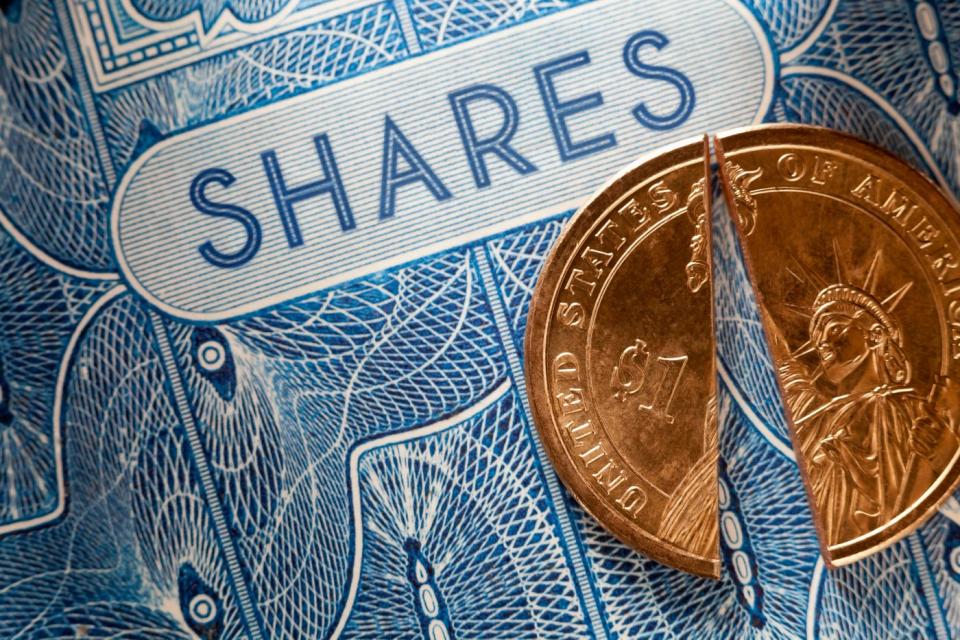At the moment, there’s probably not a hotter trend on Wall Street than artificial intelligence (AI). But companies enacting stock splits comes in a very close second.
A stock split is a mechanism that allows publicly traded companies to superficially alter their share price and outstanding share count. It’s cosmetic in the sense that a stock split doesn’t change a company’s market cap, and it has no impact on its operating performance.

Stock-split stocks come in two varieties: forward and reverse. With a forward-stock split, a public company is making its shares more nominally affordable for everyday investors who may not have access to fractional-share purchases through their broker. Meanwhile, a reverse-stock split aims to increase a company’s share price, usually with the purpose of ensuring that it meets the minimum continued listing standards for a major stock exchange.
Although both categories can produce long-term winners, most investors tend to gravitate to companies conducting forward-stock splits. High-flying stocks that need to make their share price more nominally affordable for retail investors are typically companies that have out-innovated and out-executed their peers. In other words, the type of business we’d expect to continue rising in value.
Furthermore, companies undertaking forward-stock splits have outperformed the broader market for more than four decades. According to a study from Bank of America Global Research, companies announcing forward splits have generated an average return of 25.4% (since 1980) in the 12 months following their initial split announcement. This compares to an average return of 11.9% for the benchmark S&P 500 over the same timeline.
Piling into stock-split stocks has been a winning strategy, and there’s another premier name on deck to join this exclusive club of outperformers.
Nearly a dozen high-profile businesses have announced stock splits in 2024
Before diving into Wall Street’s next stock-split stock, it’s worth recognizing that nearly a dozen time-tested businesses have announced stock splits in 2024.
Perhaps the best example of a stock-split stock that investors flocked to in droves is the company propelling the AI revolution, Nvidia (NASDAQ: NVDA). Following a nearly $3 trillion increase in market cap since the start of 2023, Nvidia’s board approved a 10-for-1 forward stock split on May 22, which became effective following the closing bell on June 7.
In a very short time span, Nvidia’s H100 graphics processing units (GPUs) became the preferred choice of pretty much every business looking to train large language models and run generative AI solutions in their high-compute data centers. With demand for Nvidia’s chips handily outweighing their supply, the company has enjoyed exceptional pricing power and operational scaling that will be written about in textbooks for decades to come.
Fast-casual restaurant chain Chipotle Mexican Grill (NYSE: CMG) also joined the club this year. With its stock trading at roughly $3,000 per share, the company’s board announced a 50-for-1 split on March 19, which went into effect after the closing bell on June 25. The magnitude of this split (50-for-1) is one of the largest in the history of the New York Stock Exchange.
Chipotle’s claim to success has always been its transparent food preparation, which involves the use of responsibly raised meats and locally sourced vegetables (when possible), as well as its limited menu. Keeping its menu relatively small helps its employees quickly prepare meals, and ensures that lines in its stores keep moving.
The other big-time stock split that investors are eagerly awaiting is networking solutions specialist Broadcom (NASDAQ: AVGO). The company’s board approved a 10-for-1 forward split on June 12, with this share price adjustment scheduled to take place following the close of business on July 12.
Similar to Nvidia, Broadcom has taken the bull the by the proverbial horns and ridden its first-mover advantages in the AI networking space to sizable gains. It introduced its Jericho3-AI chip last year, which can connect up to 32,000 GPUs in high-compute data centers. Broadcom’s AI solutions are designed to reduce tail latency and help maximize the computational potential of AI-GPUs.


Wall Street’s newest stock-split stock has gained 27,000% since its IPO
While most investors are probably eyeing Broadcom like a hawk for its upcoming stock split at the end of this week, there’s another highflier with an even more impressive long-term track record that’s imminently splitting its stock.
Since its initial public offering (IPO) in July 1983, home furnishings retailer Williams-Sonoma (NYSE: WSM) has seen its stock climb by roughly 27,000%, or more than 41,100% if you add in dividend payments.
Since its IPO, the company behind such brands as Pottery Barn, West Elm, Rejuvenation, Mark and Graham, and its namesake Williams-Sonoma, has completed seven forward-stock splits:
-
June 1986: 3-for-2 split
-
June 1989: 3-for-2
-
July 1990: 3-for-2
-
February 1994: 3-for-2
-
September 1994: 3-for-2
-
May 1998: 2-for-1
-
May 2002: 2-for-1
Following a 22-year gap since its last stock split, Williams-Sonoma’s board approved a 2-for-1 split via stock dividend on June 13. This split will take effect after the close of business on… drumroll… Monday, July 8. This means when Williams-Sonoma opens for trading tomorrow morning, it’ll be trading at closer to $140 per share.
Similar to what Walmart and Chipotle have echoed when announcing their stock splits in 2024, Williams-Sonoma is angling to “make its stock more accessible to investors and employees.” For companies with employee stock purchase plans (ESPPs), it’s often a lot easier to encourage employees to invest when the share price is lower. This seems to be the motivation to carry out the company’s eighth split since going public.
One of the key reasons Williams-Sonoma has seen its margins improve is the company’s decisive emphasis on e-commerce. While it continues to have a brick-and-mortar presence, two-thirds of the company’s sales can be traced to its digital channels. The company’s 11.1% compound annual growth rate from e-commerce since 2019 has helped to keep overhead costs under control.
Another reason for Williams-Sonoma’s ongoing success is its focus on middle-to-upper-income consumers. People with higher incomes are less likely to alter their spending habits during minor economic disruptions or periods of above-average inflation.
To add to this point, Williams-Sonoma probably couldn’t be in better position to benefit from the current economic climate. With mortgage rates soaring over the last two years, existing homeowners have very little incentive to move. This plays right into the company’s hands, with homeowners choosing to remodel or freshen up the look of their home.
But whether or not Williams-Sonoma stock is still worth buying is up for debate. While it’s been cruising past Wall Street’s consensus profit expectations for as far back as the eye can see, sales growth has stalled in recent years. Though higher margins and a hearty share repurchase program have given the company’s bottom line a nice boost, its forward price-to-earnings ratio of 17 is about 34% above its trailing-five-year average.
Unless Williams-Sonoma returns to meaningful sales growth relatively soon, squeezing more out of the proverbial orange, even with a stock split on deck, could prove challenging.
Should you invest $1,000 in Williams-Sonoma right now?
Before you buy stock in Williams-Sonoma, consider this:
The Motley Fool Stock Advisor analyst team just identified what they believe are the 10 best stocks for investors to buy now… and Williams-Sonoma wasn’t one of them. The 10 stocks that made the cut could produce monster returns in the coming years.
Consider when Nvidia made this list on April 15, 2005… if you invested $1,000 at the time of our recommendation, you’d have $771,034!*
Stock Advisor provides investors with an easy-to-follow blueprint for success, including guidance on building a portfolio, regular updates from analysts, and two new stock picks each month. The Stock Advisor service has more than quadrupled the return of S&P 500 since 2002*.
*Stock Advisor returns as of July 2, 2024
Bank of America is an advertising partner of The Ascent, a Motley Fool company. Sean Williams has positions in Bank of America. The Motley Fool has positions in and recommends Bank of America, Chipotle Mexican Grill, Nvidia, Walmart, and Williams-Sonoma. The Motley Fool recommends Broadcom. The Motley Fool has a disclosure policy.
Wall Street’s Next Stock Split — a 27,000%-Gainer Since Its IPO — Is Imminent, and I’m Not Talking About Broadcom was originally published by The Motley Fool
Source Agencies

